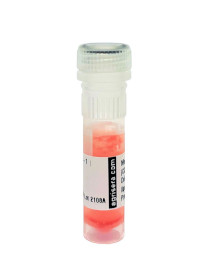1

Anti-CNX | Calnexin (monoclonal, clone 11A1)
AS17 4164 | Clonality: Monoclonal | Host: Mouse | Reactivity: Arabidopsis thaliana, Avena sativa, Glycine max, Helianthus annuus
- Product Info
-
Sub class: IgG Immunogen: V-ATPase complex from Avena sativa purified by gel filtration Ward and Sze 1992. The complex binds Calnexin. Host: Mouse Clonality: Monoclonal Purity: Cell culture supernatant. Format: Liquid Quantity: 1 ml Storage: Store at -20°C; make aliquots to avoid repeated freeze-thaw cycles. Please remember to spin the tubes briefly prior to opening them to avoid any losses that might occur from material adhering to the cap or sides of the tube. Tested applications: Immunolocalization (IL), Immunoprecipitation (IP), Western blot (WB)
Recommended dilution: 1 : 100 (WB)
Expected | apparent MW: 65 kDa - Reactivity
-
Confirmed reactivity: Arabidopsis thaliana, Avena sativa, Glycine max, Helianthus annuus Not reactive in: Zea mays
- Background
-
Background: CNX (calnexin homolog) is a calcium-binding protein involved in protein folding. It interacts with newly synthesized glycoproteins in the endoplasmic reticulum. - Product Citations
-
Selected references: Li et al. (1998). The molecular chaperone calnexin associates with the vacuolar H(+)-ATPase from oat seedlings. Plant Cell. 1998 Jan;10(1):119-30.
Li et al. (1998). The molecular chaperone calnexin associates with the vacuolar H(+)-ATPase from oat seedlings. Plant Cell. 1998 Jan;10(1):119-30.
- Protocols
-
Antibody protocols
Agrisera Western Blot protocol and video tutorials
Protocols to work with plant and algal protein extracts
- Reviews:
-
This product doesn't have any reviews.
Accessories

AS09 481 | Clonality: Polyclonal | Host: Rabbit | Reactivity: A. thaliana, B. napus, Chara australis, C. reinhardtii, C. sativus, M. perniciosa, N. benthamiana, N. tabacum, R. sativa, L.Tokinashi-daikon, O. europaea, O. sativa, P. abies, P. patens, S. oleracea, S. lycopersicum, S. tuberosum, T. aestivum, Z. mays


